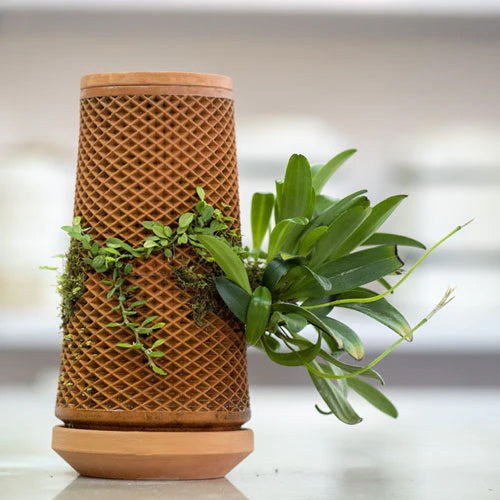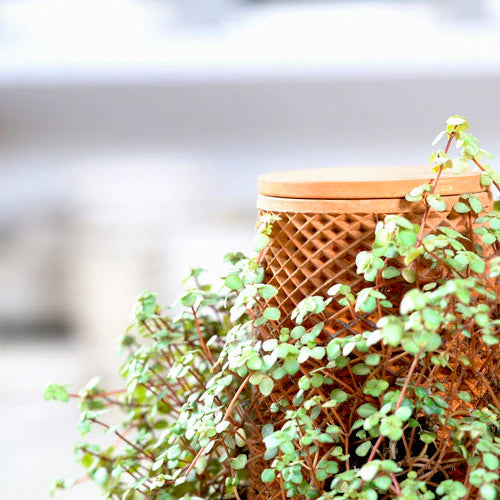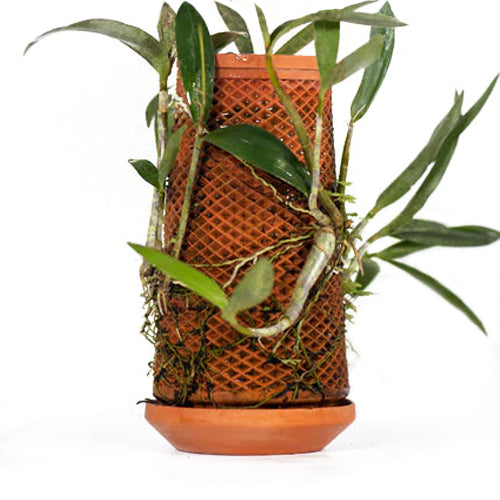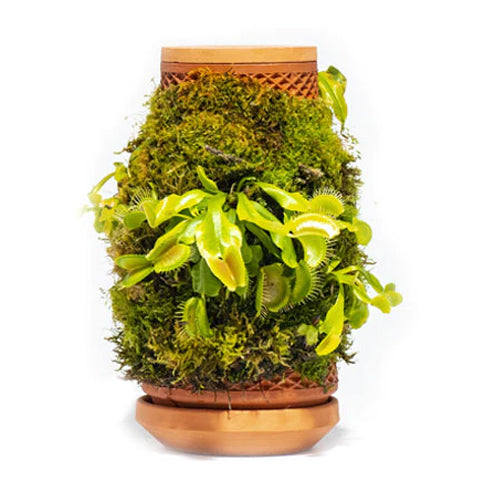Moth Orchid
Phalaenopsis orchid
Growing Method : Sowing
When selecting a young and healthy Moth Orchid for your tevaplanter, opt for one without a flowering stem. Younger plants without blooms are better able to focus their energy on establishing healthy, active roots on the tevaplanter, rather than on blooming. Should you choose to replant a plant that has a flowering stem, it's advisable to trim the stem at the plant's base. This step optimizes your plant's potential for successful growth on the tevaplanter. Secure the orchid's roots to the mid/top section of the tevaplanter's surface using the provided rubber band.
Fill the tevaplanter halfway to three quarters with filtered water to match the orchid's preference for moderate moisture. Allow the water in the tevaplanter to empty out from time to time, giving the roots periods to dry, which is crucial for preventing root rot. Initially, mist the roots twice daily until they show signs of health and activity, indicating successful acclimation. Position the tevaplanter in bright, indirect light and maintain humidity between 40-70%, possibly using a humidity tray or a clear dome during the early stages of replanting. Keep the orchid in a temperature range of 65-75°F, free from cold drafts, and apply diluted orchid fertilizer monthly.
Begonia
Begonia schulzei
Growing Method : Replanting
Begonia Schultzei is a creeping Begonia originating from Africa. This plant is especially fond of by terrarium growers. It is not an easy plant to grow at home due to its sensitivity for dry environments. It is recommended to plant this Begonia on the lower-mid part of the vessel, with time it will cover the entire surface. It is recommended to fertilize every other week during its growing period.
Gold Dollar orchid
Paphiopedilum Gold Dollar
Growing Method : Replanting
The Paphiopedilum (Lady slipper) orchid is a very beautiful family of orchids. In general, orchids are hard to grow but if you are an orchid enthusiast we recommend to try growing a Paphiopedilum. Out of all the Orchids we grew, we had the best results and easiest time growing the Paphiopedilum on the tevaplanter. Its important to choose a healthy plant with a good root system to improve the success of your growth. *Tip* Choose a plant that is showing the beginning of a new plant growth, when orchids grow a new plant they will start growing new roots as well. This is the only time new roots will grow, otherwise it can take months until the plant will develop a healthy root system.
Masdevallia orchid
Growing Method : Replanting
There are many types of Masdevallia orchids, with flowers in very diverse colors and sizes. Growing a Masdevallia orchid is recommended for expert growers - these orchids roots do not like to dry out but are also sensitive to excessive water, it’s best to mount these orchids on the central-upper part of the vessel and let the water level drop periodically. In terms of lighting, Masdevallia loves bright light without exposure to direct sunlight. It is recommended to fertilize every two weeks during the growing season. The Masdevallia is also sensitive to dry & hot environments, so it is also recommended to spray the leaves with water from time to time.
Lingua fu
Growing Method : Replanting
The Lingua fu is a very slow growing creeping fern, native to Asia and requires a more experience grower. This ferns roots likes constant moisture therefor we recommend to plant it at the lower/mid part of the vessel and always make sure that the vessel never completely dries out. The first period after replanting is a delicate period and requires patience to see success. The plant takes time to recover from the transition and to get used to its new home. After a few months it will start to grow roots on the surface and will become bigger & stronger.
Hooded Orchid
Dendrobium aphyllum
Growing Method : Replanting
Originating in Australia and unlike most orchids, it is suitable for growing outside of a greenhouse, it loves strong lighting and will be happy to get morning or afternoon sunlight. It is recommended to plant the dendrobium in the upper middle part of the tevaplanter to avoid excessive watering, and although it is an orchid that does not require a greenhouse it is advised to pamper the plant by spraying water to raise the moisture around it. It is recommended to fertilize once every two to three weeks during the growing season. We keep the water level inside the tevaplanter low for most of the time, to let the roots stay moist without being too wet or too dry. It is important to note that epiphytic orchids are slightly more difficult and a slower grow than most other plants, so those with experience or desire to learn about proper care are recommended.
Pilea glauca
Pilea libanensis
Growing Method : Replanting
Pilea glauca is an evergreen plant with small, dense leaves that usually grow in hanging pots. In nature the Pilea glauca grows in humid locations, loves strong lighting and can withstand two to three hours of direct sunlight in the morning or evening. It’s advisable to plant on the central-lower part of the tevaplanter. With good lighting conditions the plant will spread and cover most of the vessel. It is best to use the replanting method and place the Pilea glauca all around the vessel by using more than one plant. It is recommended to prune long branches for maintaining a neat and full appearance while encourage new growth.
Butterworts
Pinguicula sp
Growing Method : Replanting
The Pinguicula, a carnivorous plant from the northern hemisphere, thrives on moist rocks and tree bases, making it ideal for the tevaplanter. Its sticky leaves catch insects for food, and it blooms almost all year. Plant it in the middle-bottom of the vessel with some soil around the roots to avoid shock and aid growth; no fertilizer needed. The roots are delicate, so secure the plant with fish line until it can firmly attach itself.
Dendrobium kingianum
GROWING METHOD
Growing Method : Replanting
Dendrobium kingianum - Pink rock orchid - An orchid native to the east coast of Australia, where it grows near riverbanks on moist rocks. This Orchid is relatively durable, which in its natural environment is also exposed to direct sunlight, dryness and heat - although it will prefer a humid environment, comfortable temperatures and exposure only to gentle morning or afternoon sun. All of these make it a highly recommended plant for growing on the Tevaplanter, simulating a rocky and moist environment. Another fact that makes the kingpin a lovable orchid for growers is its lush blooms throughout spring. It is recommended to mount the plant in the central-lower part of the vessel, and fertilize once every two to three weeks. Keeping the vessel with minimal water (quarter of the vessel filled) at all times is best for this plant. Orchids do not grow roots all year round, so after mounting this Orchid months can pass before you may see new roots growing. Although it is a highly durable orchid that can survive in a variety of conditions, maintaining optimal conditions will help keep the plant beautiful and healthy, and will encourage flowering.
Barbosella orchid
GROWING METHOD
Growing Method : Replanting
Barbosella orchids come from Central and South America and most of them love high humidity, low temperatures and medium light. We have good experience growing the Barbosella orchids on the tevaplanter vessel. It’s recommended to mount them on the mid-upper part of the vessel. This orchid appreciates humid environments but also spraying it from time to time will do the job. It is a very small and slow growing plant which is why we grew the Barbosella on the tevaplanter vessel with other suitable plants, which created a diverse and beautiful result.
Venus Flytrap
Dionaea muscipula
Growing Method : Replanting
Venus flytrap grows in swamp areas without salts or minerals. In order to supplement the missing minerals the plant evolved to eat bugs with its leaves. The moment a bug sets off the trap in the mouth of the plant, it closes and traps it. Next it will start the digestion process which will help the plant receive the necessary minerals. The recommended method to start growing on the tevaplanter is replanting and it's best to keep a bit of the original soil on the roots and cover with moss (dry or alive) its important to note that this plant does not need fertilizer at all, fertilizer may damage the roots. During winters, this plant needs to go into dormancy and during these periods you must stop watering completely. An experienced grower is recommended.
Plant it the easy way
Learn how to grow on tevaplanter

Add seeds or plants
A sustainable, self-watering planter that mimics the natural habitat of plants, allowing them to grow on the surface without soil.


Add water inside
A sustainable, self-watering planter that mimics the natural habitat of plants, allowing them to grow on the surface without soil.


Watch your plant grow
A sustainable, self-watering planter that mimics the natural habitat of plants, allowing them to grow on the surface without soil.

Frequently asked questions
Frequently asked questions
Want to learn more? Read our full list of FAQs
What makes tevaplanter unique?
The tevaplanter is unique because it uses a specially engineered porous ceramic that slowly releases water, letting plants grow on the outside without soil.
Just fill the inner chamber and place seeds or plants on the surface. Roots naturally cling and drink from the moisture within. It’s durable, non-toxic, and designed to create the ideal low-maintenance home for plant growth.
What's In The Box?
- Tevaplanter vessel (porous ceramic planter)
- Ceramic lid
- Ceramic Base
- Rubber Bands (for plant mounting)
- Getting-started guide
How do plants get their nutrients or fertilizer?
Plants on the tevaplanter get their nutrients through liquid fertilizer sprayed directly onto the roots on the outside surface. The water inside provides moisture, and the fertilizer you spray gives them the nutrients they need to grow.
Do NOT add fertilizer into the tevaplanter water chamber.
What kinds of plants can I grow?
You can grow a wide variety of plants on the tevaplanter, especially ones that enjoy steady moisture on their roots. Popular choices include:
- Mosses & microgreens (chia, watercress, flax, mustard, buckwheat)
- Orchids (like Paphiopedilum, which grow very well)
- Ferns
- Vining plants
- Small tropical plants
- Aroids (certain species adapt nicely)
How long can a plant live for on the tevaplanter
A plant can live on the tevaplanter for years as long as it’s a species suited to this style of growing and you keep up with basic care (refilling water and spraying nutrients).
Some plants like mosses, ferns, vining species, and Paphiopedilum orchids can thrive long-term and stay healthy for multiple years on a single tevaplanter.
There’s no fixed lifespan, the plant will keep growing as long as it’s the right type and its needs are met.

















































